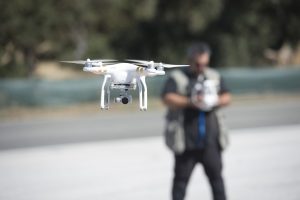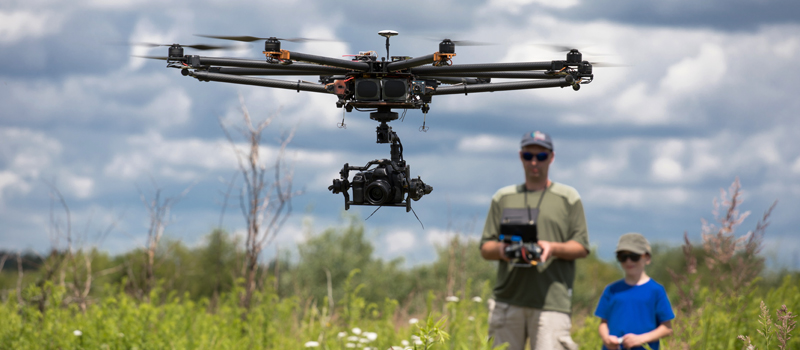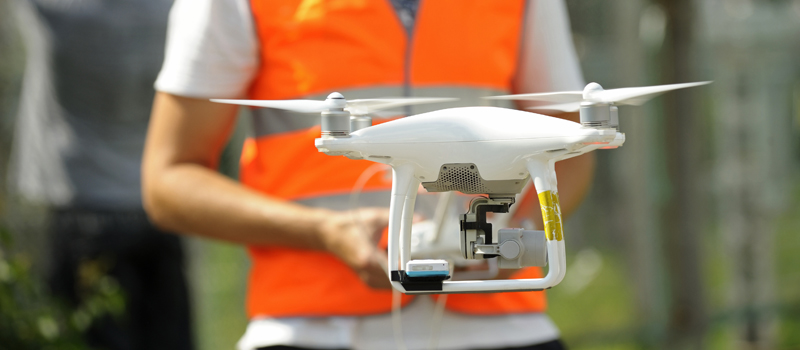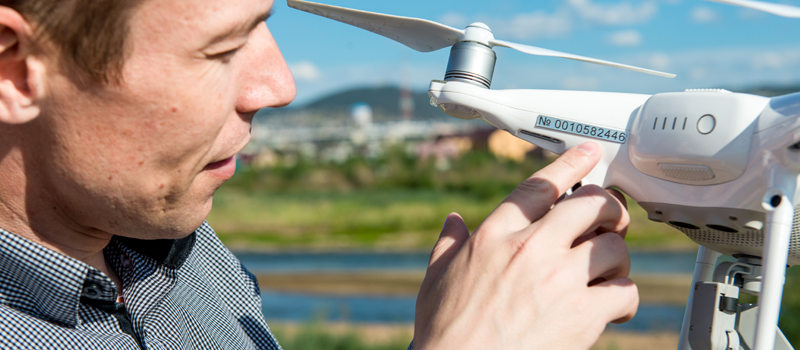-
What can you learn from hand-on drone training classes?
- Flight practice
- Flight maneuvers
- Common flight hazards
- Intelligent flight modes
- Flying without GPS
- Industry-specific drone services
- Ideal for group classes
-
Drawbacks of hands-on drone training classes
- Limited locations
- Fixed schedules
- Higher costs
- Weather considerations
-
How much will they cost?
-
Should you take a hands-on drone training class?
- Take a hands-on drone training course if…
- DON’T take a hands-on drone training course if…
-
Final thoughts
The surge in popularity of commercial drone services has given birth to another industry – training services for aspiring commercial drone pilots. Most of these training courses are theory-based and can be done online, making them a very inexpensive option for drone pilots who want to learn more skills.
However, some skills can only be taught during a hands-on session. These classes are a step up in terms of the level of interaction but are probably also much more expensive. Should you consider taking hands-on drone training classes? Are they necessary or worth the price?
What can you learn from hand-on drone training classes?

A huge part of the world has started transitioning to virtual learning platforms, so the idea of learning how to fly a drone from an online course is nothing new. It’s certainly a very flexible way of learning especially at a time when doing anything in-person can be quite challenging.
Given these implications, why would anybody want to take hands-on drone training classes? Here are just some of the stuff you can learn:
Flight practice
The biggest value of a hands-on drone training class is that it allows you to practice flying your drone under the watchful eye of an expert instructor. Much like going through driving school, having an instructor teach you in-person means that you get to learn best practices early and that you don’t develop bad drone flight habits.
In most cases, hand-on flight training sessions are preceded by classroom or online sessions that discuss the theory behind drone flight. Jumping from these learning sessions straight to hands-on flight training allows students to more easily relate theory to practice.
Flight maneuvers
While risk-taking is a behavior that’s frowned upon in the world of drone flight, it does not mean that you cannot fly with a little bit of flair. Being able to take tight turns, fly near obstacles, or fly at high speeds are skills that will probably come in handy down the line. Dynamic weather conditions are also something that you’ll need to contend with when you fly a drone.
All of these things take considerable experience to master. More than just reading about them in books or hearing about them in a lecture, it’s an entirely different thing to see how the drones react to changing conditions and to react accordingly.
Common flight hazards
Those who have taken online courses on drone flight are probably familiar with the common hazards – strong winds, large obstacles, birds, and other aircraft, just to name a few. Encountering any of these hazards could easily lead to a crash, and consequently, damage to your drone or injury to other people.
Knowing what to do when faced with these hazards is one thing, but actually being able to do them is another. In most cases, you will need to make split-second decisions to keep your aircraft safe.
This is a huge advantage of a hands-on training course in that it can provide a safe space for you to practice the appropriate reactions under the advice of an expert instructor. Considering the potential risks of a drone crash, encountering flight hazards isn’t something you want to get on-the-job training for.
Intelligent flight modes
Drones are getting smarter than ever. This means that many modern drone models come with features that have not existed before or are more refined versions of previous iterations. Exploring a drone’s intelligent flight modes is one of the more fun things for a newbie drone pilot to do, but it can also be an overwhelming task.
By picking the brain of instructors who have years of experience flying drones, you can take advantage of these intelligent flight modes early. Think of it as a way of lowering the learning curve so you can more quickly make the most out of your drone.
Flying without GPS
The GPS receiver in a drone is more than just a tool to report its location. The drone uses the GPS lock to aid in stabilization, especially when it has to hover in place. This allows drone pilots to simply take their hands off the controls when they need to – something we tend to take for granted.
With this in mind, one can imagine just how hard it can be to fly a drone with no GPS signals. If you’re used to having your drone “help” you with all its smart features, flying without GPS can be a jarring experience.
This is something you might want to learn in the relative safety of a hands-on drone training course. Flight exercises for these courses are typically done in a large open space with minimal chances of crashes or flyaways.
Industry-specific drone services
If you intend to offer drone services for highly specialized applications (mapping, precision agriculture, industrial inspect, thermal imaging, etc), then a special hands-on course is something you should seriously consider. Merely knowing how to fly a drone won’t be enough for these industries, as you will typically need to work with advanced payload and data collection software.
It’s going to be hard to pin down exactly what you will need to learn, as the skills needed can vary greatly from one industry to another. In any case, you will want to get a hands-on training course that provides certification. This certificate can be a huge marketing tool when you eventually start offering your services to clients.
Ideal for group classes
With businesses and organizations adopting the use of drone technology for their day-to-day operations, it is no longer uncommon for them to assign several personnel to handle drone operations. A hands-on drone training course is perfect for such a group, as it ensures that each member of the team learns at the same pace and has been taught the exact same lessons.
Many training providers offer group courses that are much cheaper on a per-person basis. Aside from basic flight training, a hands-on drone course can also be instrumental in helping an organization prepare their drone pilots for the Part 107 knowledge test – a requirement to earn the license that allows for commercial drone operations.
Drawbacks of hands-on drone training classes

Compared to virtual training platforms, going back to old-fashioned hands-on training is certainly going to feel like taking a step back in terms of convenience. Doing hands-on training means having to show up – you don’t have the option of stopping and resuming the training materials whenever you want.
Before starting a hands-on drone training course, make sure that these are drawbacks that you could live with:
Limited locations
One thing that a hands-on training course needs is a good facility. More important than a classroom for discussions, they will also need to have a wide-open space for safe drone flight exercises. You’re extremely lucky if you have such a facility near you. Otherwise, you may have to drive a few hours every session just to get to that hands-on drone training course.
Fixed schedules
Between working multiple jobs, household responsibilities, and the stress of a pandemic, everyone’s pretty busy nowadays. On-demand online training courses have the huge advantage of allowing students to pull up the training materials on their computers or phones whenever they want to. With a virtual training course, you won’t have to travel or keep up with anyone else’s pace.
Hands-on drone training courses are typically offered across several sessions and each one has a set schedule. Whether it’s just for three or five sessions, this is still a huge time commitment considering everyone’s busy schedules.
Higher costs
A virtual training course is a very inexpensive way to learn about any topic related to drone flight. Since there are practically no operating costs involved, these virtual training courses usually cost anywhere between $100 to $200. Many of them provide lifetime access and materials that can be accessed via both computers and mobile devices.
A hands-on drone training course, on the other hand, is a lot more expensive. Not only do you have to pay for the time that the instructor spends doing in-person sessions, but you’ll also have to pay for use of the training facilities. These add up to a pretty large amount and can be a huge capital expense, especially for a business who is just starting out.
Weather considerations
The major reason why you would want to take a hands-on training course is to fly your drone under expert supervision. If so, then the unpredictability of the weather is something you’ll have to deal with. Hands-on drone classes can be postponed at a moment’s notice due to bad weather, which means having to squeeze in another session into your already-packed schedule.
How much will they cost?
This question is pretty tough to answer, as prices vary greatly from one training provider to the next. You will also need to consider exactly what you’re training for. For instance, a basic drone flight training course will probably be cheaper than a course that focuses on 3D mapping or thermal imaging.
Just to give ballpark figures for typical hands-on drone training courses, here are sample rates for some of the more popular ones:
- Basic hands-on drone flight training courses start at around $300 for a two-hour session
- Group sessions can be a bit less expensive at about $200 per person for a two or three-hour session
- DJI offers a DJI Academy UAS Pilot Training Level 1 Certification for $1449. The course is a combination of both online and hands-on training. The hands-on portion takes full three days.
- More specialized training courses, such as those for aerial inspection, can cost around $1500 for a course that spans two or three days.
Should you take a hands-on drone training class?

As with any decision worth making, there are both good and bad sides to taking a hands-on drone class. Yes, you learn and gain confidence about drone flight through actual flight exercises. There’s also nothing quite like seeing for yourself how an experienced pilot flies drones.
However, hands-on drone training courses also require a huge commitment in terms of time, effort, and money. Not only are hands-on courses much more expensive than virtual alternatives but signing up for one also means having to show up to a training facility according to a non-negotiable schedule.
To help you make a decision, here’s how we would break down the choices:
Take a hands-on drone training course if…
Money and time are not an issue
While there’s no question that there is value in taking a hands-on drone training course, it can also be a huge inconvenience if you’re on a budget or you simply don’t have the time. If neither are relevant problems to you, then there’s no reason not to sign up for one. Hands-on drone training will certainly come in handy, no matter your level of experience in drone flight.
You’re planning to offer professional drone services
Compared to online training courses, there is an intangible “premium” to finishing a hands-on training course. If you’re planning to offer your services as a drone pilot to businesses or companies, then you’ll need this premium to be competitive. It’s a proverbial wild west out there and you’ll need all the advantage you can get.
DON’T take a hands-on drone training course if…
You’re just flying recreationally
Here’s the thing about hands-on training courses – a lot of drone pilots have not been through them at all. Much like riding bicycles, drone flight is largely a skill that people learn just by doing. Despite all these fancy training courses and facilities, the reality is that you can still get by with learning how to fly a drone as you go.
This does not discount the value of going through actual training, whether in-person or virtual. Even if you get to learn to fly a drone all by yourself, it’s still worth the time to read up on relevant drone laws and established safety practices. Ignorance is no longer an excuse – even if you don’t have the cash to sign up for an actual training course.
Your schedule isn’t flexible
Taking a hands-on training course is going to feel a lot like going back to school. Miss a class and you could end up hopelessly lost by the time you can show up again.
If you have a job that demands too much of your time or if you simply can’t afford to make the drive on weekends, then a virtual training course may be the more practical option for you.
Final thoughts
Most of us have memories of having to attend sports camps or take music lessons back when we were kids. A hands-on drone training course is a lot like that. The only difference is that we’re adults now with more demanding lives and bigger responsibilities. While there is no question that hands-on training courses offer a lot of value for drone pilots, they also aren’t for everyone.
The biggest benefit of a hands-on training course is it provides an environment where beginner pilots can practice flying a drone in an environment that is safe. The supervision of an expert instructor also ensures that students don’t end up developing bad habits that they will need to unlearn later on.
If you simply can’t afford to sign up for a hands-on training course, you may want to consider Pilot Institute’s range of online training courses. These courses are convenient, full of content, and very affordable.



